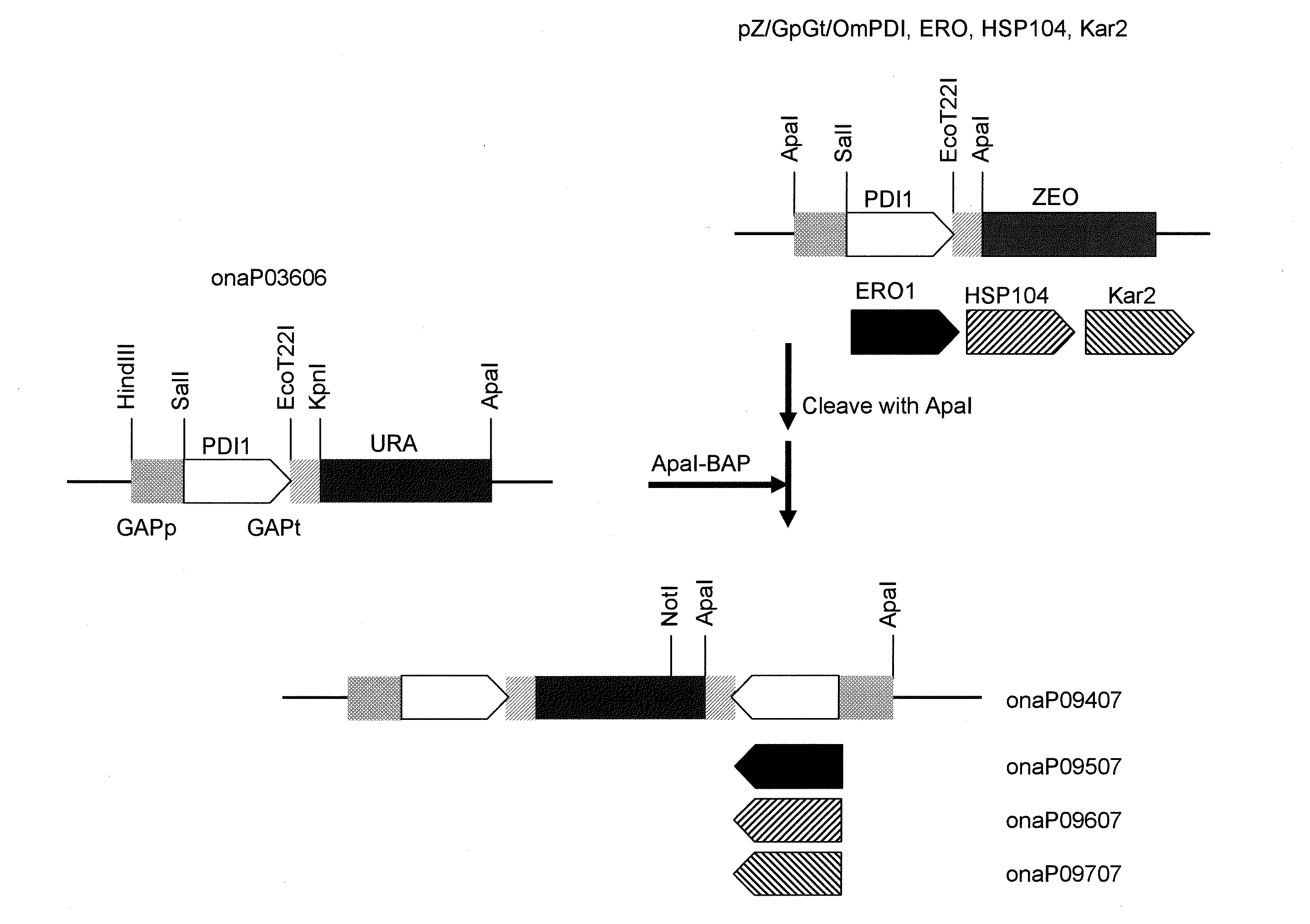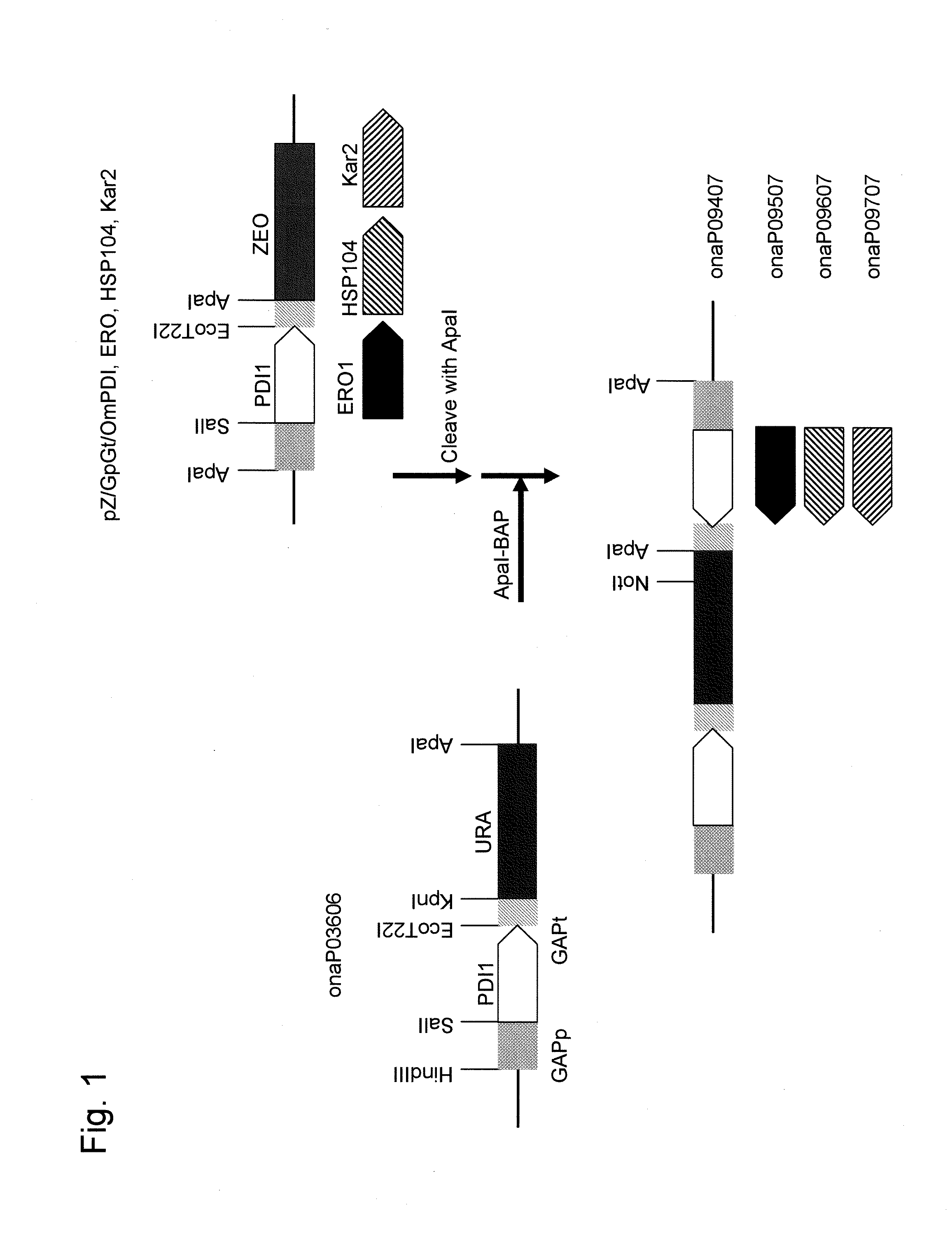Method for high-level secretory production of protein
a secretory production and high-level technology, applied in the field of high-level secretory production of proteins, can solve the problems of inability to achieve secretory production, inability to use pdi or pdi in combination with bip, and inability to achieve any effect of secretory production, etc., to accelerate foreign protein secretion
- Summary
- Abstract
- Description
- Claims
- Application Information
AI Technical Summary
Benefits of technology
Problems solved by technology
Method used
Image
Examples
example 1
Construction of Vector for Antibody Gene Introduction
(1) Construction of Vector for Antibody Gene Introduction Carrying a Zeocin-Resistant Gene as a Selection Marker and Comprising the Gap Gene Promoter and the Terminator Cassette
[0151]In order to prepare a Zeocin-resistant gene marker, a synthesized DNA fragment as shown in SEQ ID NO: 15 was subjected to double digestion with HindIII and KpnI restriction enzymes to obtain a DNA fragment containing a Zeocin-resistant gene.
[0152]pOMexGP1U disclosed in WO 2003 / 091431 was cleaved with SpeI, blunt-ended, and then ligated. The SalI site and the EcoT22I site of the resulting plasmid were subjected to linker change with the SpeI site and the BamHI site, respectively. Thus, the pOMexGP1UΔSp plasmid was obtained. The resulting pOMexGP1UΔSp was subjected to double digestion with HindIII and KpnI restriction enzymes to isolate a fragment containing the GAP gene promoter and the terminator, and a DNA fragment containing the Zeocin-resistant gen...
example 2
Construction of Expression Vector for Antibody Gene
[0162]In order to express the Kar2 signal derived from O. minuta (hereafter refers to as the “OmKar2 signal”) and the light chain and the heavy chain of the anti-TRAIL receptor antibody as a fusion protein, the OmKar2 signal sequence was ligated to the anti-TRAIL receptor antibody gene (WO 2001 / 083560, synthesized by Takara Bio while taking the frequency of the use of codons of O. minuta into consideration) via overlap extension PCR using the oligonucleotide primers below.
[0163]
For OmKar2 signal and heavy chain of anti-TRAILreceptor antibody(SEQ ID NO: 20)Om-Kar2-Sac:5′-GGAGCTCATGTTTAAGTTCAACCGCTC-3′(SEQ ID NO: 21)OmKar-SanH-R3:5′-CAACGAGTTGAACCTCCGCCTCTGCTTCCACG-3′(SEQ ID NO: 22)OmKar-SanH-F3:5′-CGTGGAAGCAGAGGCGGAGGTTCAACTCGTTG-3′(SEQ ID NO: 23)SanH-Nhe:5′-GGCTAGCGGAGGAAACGGTAAC-3′For OmKar2 signal and light chain of anti-TRAILreceptor antibody(SEQ ID NO: 24)Om-Kar2-Spe:5′-GACTAGTATGTTTAAGTTCAACCGCTC-3′(SEQ ID NO: 25)OmKar-SanL-R3:...
example 3
Construction of Expression Vector for Chaperone Gene Alone
(1) Construction of Constitutive Expression Vector for OmPDI1 Gene
[0168]The gene consisiting of the nucleotide sequence as shown in SEQ ID NO: 1 (1551 bp) is deduced to encode a protein consisiting of the amino acid sequence as shown in SEQ ID NO: 2 (516 amino acid residues).
[0169]The above protein has nucleotide sequence homology of about 60.5% to PDI1 (YCL043C) of S. cerevisiae and putative amino acid sequence homology of about 46.9%. The protein was deduced to be a functional homolog that also comprises two thioredoxin-like domains, CGHC (Cys-Gly-His-Cys), in PDI1 of S. cerevisiae, and it was designated as OmPDI1 as PDI1 of O. minuta. Since the nucleotide sequence of OmPDI1 comprises the cleavage sites for EcoT22I and SalI restriction enzymes, the EcoT22I and SalI restriction enzyme sites were modified via overlap extension PCR using the oligonucleotide primers below.
[0170]
(SEQ ID NO: 28)OMPDI1SAL:5′-GGTCGACATGAAGTTATTTGGA...
PUM
 Login to View More
Login to View More Abstract
Description
Claims
Application Information
 Login to View More
Login to View More - R&D
- Intellectual Property
- Life Sciences
- Materials
- Tech Scout
- Unparalleled Data Quality
- Higher Quality Content
- 60% Fewer Hallucinations
Browse by: Latest US Patents, China's latest patents, Technical Efficacy Thesaurus, Application Domain, Technology Topic, Popular Technical Reports.
© 2025 PatSnap. All rights reserved.Legal|Privacy policy|Modern Slavery Act Transparency Statement|Sitemap|About US| Contact US: help@patsnap.com



